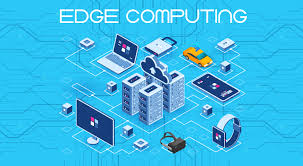info@gladsme.in
+91.8891968718
Unlocking the Power of Edge Computing: Transforming Data Processing at the Edge
Unlocking the Power of Edge Computing: Transforming Data Processing at the Edge

In the rapidly evolving landscape of technology, edge computing is emerging as a revolutionary force. By bringing computation and data storage closer to the sources of data, edge computing enhances the speed and efficiency of data processing. This blog explores the fundamentals of edge computing, its benefits, applications, and how it is transforming various industries.
What is Edge Computing?
Edge computing refers to the practice of processing data near the edge of the network, where the data is generated, instead of relying on a centralized data-processing warehouse. This method reduces latency, conserves bandwidth, and improves the real-time data processing capabilities crucial for modern applications.
Benefits of Edge Computing
Reduced Latency: By processing data closer to the source, edge computing significantly cuts down on the time it takes to process and respond to data.
Improved Bandwidth Efficiency: Edge computing reduces the amount of data that needs to be transmitted to centralized data centers, conserving bandwidth and lowering costs.
Enhanced Security and Privacy: Processing data locally can improve security by reducing the number of times data is transmitted across the network, minimizing potential interception points.
Reliability and Resilience: Localized data processing can continue to function even if the connection to a central data center is lost, ensuring higher system reliability and resilience.
Applications of Edge Computing
Internet of Things (IoT): Edge computing is critical for IoT applications, where devices like smart sensors and wearables generate vast amounts of data that need to be processed in real-time.
Autonomous Vehicles: Self-driving cars require real-time data processing to navigate safely and efficiently, making edge computing indispensable in this field.
Healthcare: In medical settings, edge computing allows for the quick processing of patient data, enabling real-time monitoring and rapid decision-making.
Industrial Automation: Factories and industrial environments use edge computing to process data from machinery and systems, optimizing performance and maintenance schedules.
Smart Cities: Edge computing supports the infrastructure of smart cities by managing data from traffic systems, utilities, and public services to improve efficiency and responsiveness.
The Future of Edge Computing
As the volume of data generated by connected devices continues to grow, the demand for edge computing solutions will only increase. Innovations in this field are expected to drive significant advancements in artificial intelligence, machine learning, and other technologies that rely on real-time data processing.
Edge computing is transforming the way we handle data by bringing processing power closer to the source. Its benefits in terms of speed, efficiency, and security are paving the way for new applications and innovations across various industries. As technology continues to advance, edge computing will undoubtedly play a crucial role in shaping the future of data processing and analytics.
Related Blogs

The Importance of Data Structures in Software Development
Read More...
Exploring Machine Learning Algorithms: A Beginner's Guide
Read More...
The Evolution of Programming Languages: From Assembly to Rust
Read More...
Understanding Big O Notation: A Guide for Developers
Read More...Subscribe for our Newsletter
Subscribe to elevate your software game! Stay updated on the latest trends, coding insights, and exclusive promotions with our newsletter.
